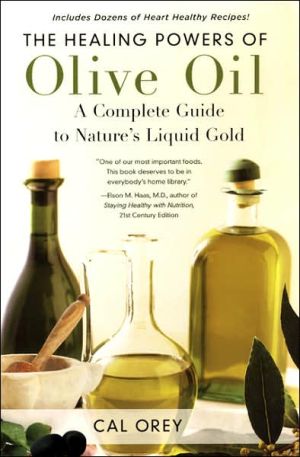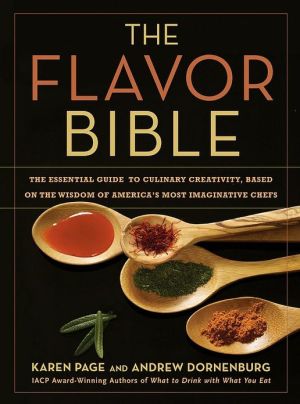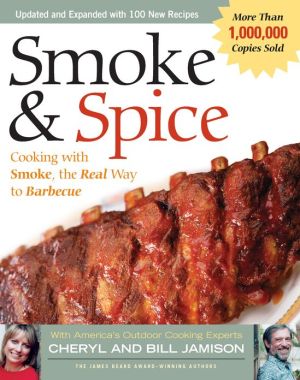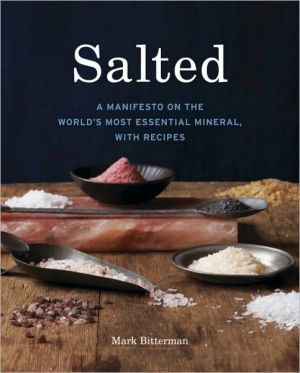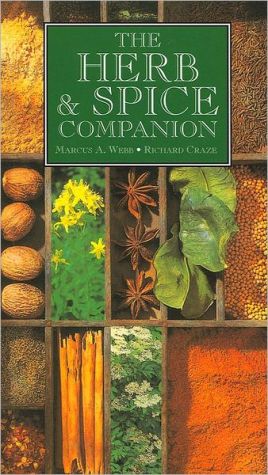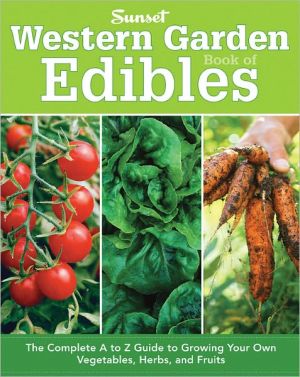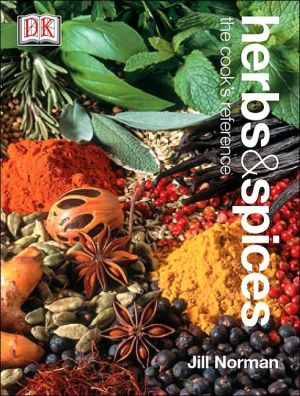The Healing Powers of Olive Oil
From ancient times to present-day, olive oil has been used for everything from health ailments to beauty and the home and so much more. Now evidence shows that a diet based on olive oil can add years to your life and may even prevent some diseases. Health author-journalist Cal Orey has consulted top doctors, nutritionists, olive oil producers, and chefs, getting the most up-to-date information on the many benefits of olive oil, such as: Health Improvements: Relieving arthritis aches,...
Search in google:
LOSE WEIGHT.LOWER CHOLESTEROL AND BLOOD PRESSURE.PREVENT HEART DISEASE AND CANCER...LIVE LONGER...AND SO MUCH MORE!DISCOVER THE AMAZING POWERS OF OLIVE OIL!From ancient times to present-day, olive oil has been used for everything from health ailments to beauty and housekeeping and so much more. Now evidence shows that a diet based on olive oil can add years to your life and may even prevent some diseases. Health author-journalist Cal Orey has consulted top doctors, nutritionists, olive oil producers, and chefs, getting the most up-to-date information on the many benefits of olive oil, such as—Health Improvements—• Relieving arthritis aches• Inhibiting breast and colon cancer• Preventing diabetes• Reducing pain• Staving off ulcers• Fighting impaired memoryHome Cures—• Soothing diaper rash• Reducing hair loss• Cleaning your house, naturally• Minimizing stretch marks and wrinkles• Zapping ticks and conditioning your pet's coat• And more information that everyone worldwide should know!Includes dozens of delicious recipes that make olive oil a vital part ofa long and healthy life!"The best and highly practical information about the core of the longevity-boosting Mediterranean diet."—Karlis Ullis, M.D., Medical Director of Sports Medicine and Anti-Aging Medical Group in Santa Monica, California
THE HEALING POWERS OF Olive Oil\ A Complete Guide to Nature's Liquid Gold \ \ By CAL OREY \ KENSINGTON BOOKS\ Copyright © 2008 Cal Orey\ All right reserved.\ ISBN: 978-0-7582-2221-3 \ \ \ \ Chapter One\ The Power of Olive Oil \ * * *\ Except the vine, there is no plant which bears a fruit as of great importance as the olive. -Pliny\ In the fifties, I grew up in San Jose, California, a place once known for its plentiful prune tree orchards. Today, as a nature-loving Northern Californian who currently lives amid tall pine trees in South Lake Tahoe, I was pleasantly surprised to discover that within three hours of my mountain-style home-with rolling hills much like in Italy, Spain, and Greece-olive groves are growing and people are producing olive oil, known as liquid gold, in a Mediterranean-type weather in the Golden State.\ When I was in my late twenties, it was my dream to go to Europe. I dog-eared one of those Europe-on-a-shoestring-budget travel books and planned my trip. But I opted to go to graduate school instead. So, I never got to enjoy the exotic Mediterranean countries or taste the European cuisine-including its wide world of olive oil.\ The closest I've come to Italy, the second largest producer of olive oil, is by watching the film Under the Tuscan Sun, which is about a divorced writing professor and book reviewer-played by Diane Lane-and based loosely on a novel created by Frances Mayes, who taught classes at my alumni college, San Francisco State University. With envy, I viewed her protagonist, Frances, learning to live and laugh again thousands of miles away from the San Francisco Bay Area. In Tuscany, where she relocates, it's the eccentric, down-to-earth locals and observing an earthy harvest of olives (right outside her new home) that finds a place in her heart.\ In the real world, I sit here in my study with snow-covered ground outdoors in the California Sierras and fantasize about how wonderful it would be to live in Italy amid olive trees. But, whisking off in a plane to Europe isn't going to happen for me today or tomorrow. Still, I will take you along with me to visit real people and real places where you will get a real flavor of the Mediterranean basin and of the healing powers of olive oil.\ The Olive Yields a Powerful Oil\ Olive oil has been praised by people as one of Mother Nature's most healthful fats, especially if it is extra virgin olive oil. And now, olive oil-and other healing oils-are making the news worldwide, and are here to stay in homes, restaurants, and even fast-food chains.\ People from all walks of life-including some olive oil pioneers and contemporary medical experts-believe olive oil helps fight body fat and keeps blood pressure down as well as heart disease at bay. Olive oil is also known to help relieve colds and maintain healthy skin.\ Jean Carper, a leading authority on health and nutrition, points out that new Italian research finds olive oil contains antioxidants, similar to those in tea and red wine, that fight heart disease, including LDL cholesterol's ability to clog arteries.\ Dietician and nutrition consultant Pat Baird, author of The Pyramid Cookbook: Pleasures of the Food Guide Pyramid, touts the golden liquid, too. "I love the whole idea of olive oil's versatility. I use it for baking, as well as salad dressings and sautéing. Olive oil has been around for a long time, and the more we know about it, the more we learn about its great contribution to good health."\ Liz Applegate, Ph.D., a renowned health, nutrition, and fitness expert, wrote in her book 101 Miracle Foods That Heal Your Heart, "Rich in history, and even richer in heart-healthy benefits, olive oil is the 'king' of oils."\ Most important, like apple cider and red wine vinegars, extra virgin olive oil contains polyphenols, naturally occurring compounds that act as powerful antioxidants (disease-fighting enzymes that protect your body by trapping free-radical molecules and getting rid of them before damage occurs).\ Olive Oils with Polyphenols\ Keep in mind, if you're a health-conscious person like I am, you'll quickly ask, "Which olive oil has the highest polyphenols?"\ "Phenol content is determined by olive variety, time of picking, olive condition and processing method, whether the oil is refined, and the length of time the oil has been treated," explains Dr. John Deane, an internal medicine specialist in Marin County, California, and an olive oil expert who writes for The Olive Oil Source newsletter.\ That said, it's the Tuscan varieties, points out Deane, such as Coratina, Frantoio, Lucca, and Pendolino, that boast the highest good-for-you polyphenols. "These oils are valuable in that when blended with a low polyphenol oil, they will extend the shelf life by preventing rancidity," he adds.\ The olive oil master also says that the bulk of olive oil we consume in America comes from Italy and Spain. But the glitch is, that means it's most likely refined-and lower in phenols.\ So, what do you do if you're on a mission to get an olive oil that is polyphenol-rich? According to Deane, if you choose a brand that reads "extra virgin," boasts the California Olive Oil Council (COOC) seal, is from the "current harvest season," and has been properly stored, you should be holding a healthful bottle of olive oil, like a good bottle of antioxidant-rich wine, with polyphenols.\ Another interesting note I discovered is that olive oils that are higher in polyphenols tend to be harsher, bitter, and stronger flavored. That makes me think of dark chocolate. It is not as sweet and mellow as milk chocolate. But then, it's the darker chocolate that contains the heart-healthy antioxidants, right? And, like other healthful foods, such as olive oil, sometimes it takes a while to acquire a taste for them.\ Olive Oil Basics 101\ Olive oil, one of the oldest vegetable oils, comes from the fruit of the olive tree (Olea europae L.), which was originally found in the Mediterranean basin. It has been used since biblical times in cooking, as a medicinal agent, in cosmetics, in soaps, and even as fuel for lamps.\ So, what exactly is olive oil, anyhow?\ Olive oil can be made from a wide variety of olives, such as black and green olives, and other types. "There are at least 30 olive varieties used extensively for olive oil and then add another 100 or so depending on where you are. In total 300 plus varieties," explains Judy Ridgway. Of course, I have learned that this number varies depending on your olive oil reference source.\ The following kinds of olives-including the polyphenol-rich ones-used for olive oils are listed from A to Z.\ OLIVE POTPOURRI\ Kind Olives Grown From Olive Oil Taste\ Arbequina Puglia, Italy Fresh and fruity\ Barnea Australia, Israel, New Sweet almonds, Zealand sometimes with a banana flavor Biancollia Sicily Herbal tomatoes\ Cerasuolo Sicily Apples, sweet herbs, and tomatoes\ Cornatina Carato (near Barl) and Fruity, bitter, and Puglia, Italy peppery with a tinge of sweet taste; high in polyphenols\ Cornicabra Spain Light bitterness, peppery, and fruit notes; younger oils pungent, smooth, like an almond aftertaste\ Frantoio Tuscany, Italy; Fruity, aromatic, and Argentina; Chile; a peppery taste; late California; New bloomers soft, almost Zealand; Australia sweet, like a mild almond nuts, and light herbs\ Tonda Iblea Sicily Crushed tomatoes\ Sources: Judy Ridgway and The Olive Oil Companion.\ The Art of Production\ From harvesting to bottling, the time and tender loving care put into nature's olives and making premium quality olive oil is the same today as it was centuries ago. The bulk of olive oil is made in Mediterranean countries such as Spain, Italy, and Greece, with a small percentage produced in California, Australia, parts of South America, and other countries.\ Harvesting: Varying from region to region, olive harvests usually take place between mid-November and mid-January. During this time, olive oil producers are much like writers on deadline-busy, excited, and did I say busy? The olives are collected in nets that are placed around the foot of the tree (see the film Under the Tuscan Sun to get a visual image), and within 24 hours of harvest, the olives are taken directly to a mill to be pressed into olive oil.\ Pressing: An olive paste is created by crushing the whole fruit (yes, including the pits that you spit out when munching on your favorite olives). This is usually done under granite or steel millstones that resemble those used more than 1,000 years ago. The paste is then spread onto thin mats, which are stacked and placed into a machine press. As the press applies several hundred pounds of pressure, oil and water seep out of the mats and drip into collection vats. This process requires no heat-hence the term "first cold-pressed" olive oil.\ A bit confused about the term "cold press," let alone "first," I contacted food-science columnist Robert L. Wolke, professor emeritus of chemistry at the University of Pittsburgh and author of What Einstein Told His Cook: Kitchen Science Explained (W.W. Norton & Company, 2005). He gave me the lowdown on cold-pressing semantics: "Cold pressed means that the olives or the press are not heated or treated with hot water. The maximum allowed temperature for extra virgin oil is 25°C or 77°F. Heat would give a higher yield of oil during the pressing, but would compromise the quality and flavor. But that 'cold' or unheated pressing is the only pressing. The olives are virtually never pressed a second time at higher pressure, which would just squeeze bitter juices out of the pits. Instead, the remaining oil is coaxed out with hot water or an organic solvent. That oil, however, is a lower quality and cannot be labeled 'extra virgin.' Still, producers like to claim 'first pressing' for their extra virgin oils. It just sounds impressive."\ Other methods, I learned, are also sometimes used to extract oil from olives. One is centrifugation. "A centrifuge spins materials around rapidly, like the spin cycle on a washing machine," explains Wolke. "After the pressing, it separates oil from the watery juices." However, mechanical pressing is the most popular way.\ After pressing, the oil is then left to settle, and any vegetable water is removed by centrifuge machines. When the olive oil is created, it is set aside to be evaluated for its quality and categorized.\ Grades of Olive Oil\ Extra virgin: Extracted from the highest-quality olives. It must have less than 1 percent natural acidity. Its "fruity" flavor is intense and great in salads.\ Virgin: Processed mechanically (using pressure) and without heat, which changes the oil's acidity to 1 to 5 percent. It's recommended for use in salad dressings and marinades.\ Pure: A mix of refined olive oil (treated with steam and chemicals) and virgin oils. Its acidity ranges from 3 to 4 percent. Less costly, it's most often used in cooking.\ Extracted and refined: Made from whole cull olives and extracted during a second pressing with a chemical solvent; virgin oil is added for flavor.\ Pomace: Made by a chemical extraction of the residue left over after the crushing and second pressing of the olives. It contains 5 to 10 percent acidity; virgin oil is added for flavor.\ (Continues...)\ \ \ \ \ Excerpted from THE HEALING POWERS OF Olive Oil by CAL OREY Copyright © 2008 by Cal Orey. Excerpted by permission.\ All rights reserved. No part of this excerpt may be reproduced or reprinted without permission in writing from the publisher.\ Excerpts are provided by Dial-A-Book Inc. solely for the personal use of visitors to this web site. \ \
Foreword viiAcknowledgments ixA Time for Olive Oil 1The Power of Olive Oil 3A Genesis of the Olive 15Olive Oil 25A Historical Testimony 27Where Are the Secret Ingredients? 37Why Is Olive Oil So Healthy? 45The Keys to the Mediterranean Diet 53Other Natural Oils 61Flavored Olive Oils 63More Healing Oils 69Youth in a Bottle 81Combining Olive Oil and Vinegar 83The Elixir to Heart Health 92The Olive Oil Diet 99Antiaging Wonder Food 107Olive Oil Home Remedies 117Cures from Your Kitchen 119Future Olive Oil 137Olive Oil Mania: Using Olive Oil for the Household, Kids, Pets, and Beauty 139Olive Beautiful 159Olive Oil Producers, Tasting Bars, and Tours 167Olive Oil Is Not for Everyone: Some Bitter Views 183The Joy of Cooking with Olive Oil 188Olive Oil Recipes 201Olive Oil Bon Appetit! 203OliveOil Resources 241Where Can You Buy Olive Oil? 243Notes 255Selected Bibliography 261
